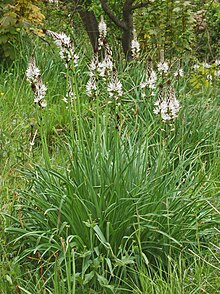Asphodelaceae
| Asphodelaceae | |
|---|---|

| |
| Asphodelus macrocarpus | |
| Scientific classification | |
| Kingdom: | Plantae |
| Clade: | Tracheophytes |
| Clade: | Angiosperms |
| Clade: | Monocots |
| Order: | Asparagales |
| Family: | Asphodelaceae Juss.[1] |
| Subfamilies | |
For genera, see section § Genera. | |
Asphodelaceae is a
The family has a wide, but scattered,
applications.Description
Members of the Asphodelaceae are diverse, with few characters uniting the three subfamilies currently recognized. The presence of anthraquinones is one common character. The flowers (the inflorescence) are typically borne on a leafless stalk (scape) which arises from a basal rosette of leaves. The individual flowers have jointed stalks (pedicels). A disk of woody tissue (a hypostase) is present at the base of the ovule.[1]
The subfamily Xanthorrhoeoideae contains only the genus
Systematics
Phylogeny
The order Asparagales can be divided into a basal paraphyletic group, the "lower Asparagales", which includes the Asphodelaceae as defined here,[4] and a well-supported monophyletic group of "core Asparagales", comprising Amaryllidaceae sensu lato and Asparagaceae sensu lato.[5] Three separate families were at one time recognized (e.g. in the first APG system of 1998): Asphodelaceae, Hemerocallidaceae and Xanthorrhoeaceae. Molecular phylogenetic studies have shown that the three are closely related,[1][6] although Rudall considered that the combination into a single clade was not supported by morphological analysis.[7] The most recent APG classification, the APG IV system of 2016, places the three former families into a single family, the Asphodelaceae sensu lato. The former families are treated as three subfamilies: Asphodeloideae, Hemerocallidoideae and Xanthorrhoeoideae.[8]
The following
| Asphodelaceae |
| ||||||||||||||||||||||||||||||||||||
History
The family now called Asphodelaceae has had a complex history; its circumscription and placement in an order have varied widely.
In the
In some of the older
The decision to group three formerly separate families, Asphodelaceae sensu stricto, Hemerocallidaceae and Xanthorrhoeaceae, into a single family first occurred as an option in the APG II system of 2003. The name used for the broader family was then Xanthorrhoeaceae;[13] earlier references to the Xanthorrhoeaceae relate only to the subfamily Xanthorrhoeoideae. The changes were a consequence of improvement in molecular and morphological analysis and also a reflection of the increased emphasis on placing families within an appropriate order.[14][7][15]
The APG III system of 2009 dropped the option of keeping the three families separate, using only the expanded family, still under the name Xanthorrhoeaceae.[14] Anticipating a decision to conserve the name Asphodelaceae over Xanthorrhoeaceae (which came to pass in 2017), the APG IV system uses Asphodelaceae as the name for the expanded family.[2] The three previous families were then the subfamilies
The family Asphodelaceae was made a
Genera
The genera listed below are from the
|
Subfamily Asphodeloideae Burnett
|
Subfamily Hemerocallidoideae Lindley
|
Subfamily
|
The nothogenus Gasteraloe contains hybrids between Aloe and Gasteria.
The genus
References
- ^ a b c d Stevens, P.F. "Asphodelaceae". Angiosperm Phylogeny Website. Missouri Botanical Garden. Retrieved 12 June 2016.
- ^ .
- .
- doi:10.1139/b97-044
- ^ Stevens, P.F. "Asparagales". Angiosperm Phylogeny Website. Missouri Botanical Garden. Retrieved 12 June 2016.
- .
- ^ S2CID 24862159.
- ^ .
- ISSN 0065-6275.
- ISBN 978-3-540-64060-8.
- ISBN 9780231038805.
- ^ Beadle, N.C.W. (1981). The Vegetation of Australia. London: Cambridge University Press.
- .
- ^ hdl:10654/18083.
- JSTOR 2992015.
- ^ Search for "Xanthorrhoeaceae", World Checklist of Selected Plant Families, Royal Botanic Gardens, Kew, retrieved 25 February 2013
External links
 Media related to Asphodelaceae at Wikimedia Commons
Media related to Asphodelaceae at Wikimedia Commons Data related to Asphodelaceae at Wikispecies
Data related to Asphodelaceae at Wikispecies- Xanthorrhoeaceae At: Angiosperm Phylogeny Website At: Missouri Botanical Garden Website
- Xanthorrhoeaceae in L. Watson and M.J. Dallwitz (1992 onwards). The families of flowering plants: descriptions, illustrations, identification, information retrieval. Version: 9 March 2006. https://web.archive.org/web/20070103200438/http://delta-intkey.com/
- NCBI Taxonomy Browser
- links at CSDL, Texas Archived 12 October 2008 at the Wayback Machine
- Asphodelaceae in BoDD – Botanical Dermatology Database
